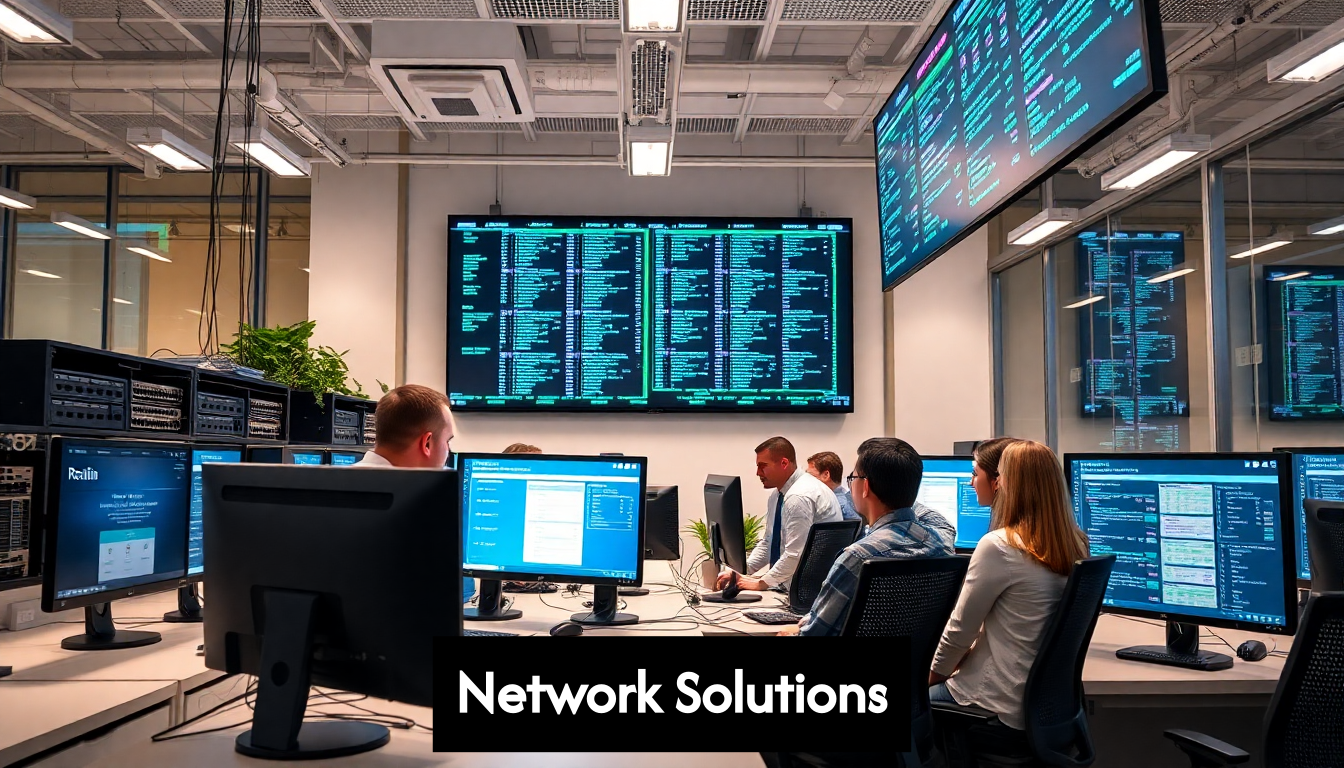
Network solutions are the unseen pillars of our digital world. They are critical for connecting devices, applications, and systems seamlessly. In fact, 80 percent of businesses now cite reliable networking as vital to their daily operations. But here’s the kicker — most people think network solutions are just about hardware and wires. The reality? It’s not just the technology that counts; it’s how these solutions empower organisations to innovate and thrive in today’s fast-paced environment.
Understanding Network Solutions Today
In today’s rapidly evolving digital landscape, network solutions form the backbone of our interconnected world. These solutions encompass the hardware, software, services, and protocols that enable data communication between devices, applications, and systems. As businesses and organisations become increasingly dependent on digital infrastructure, understanding network solutions has never been more critical.
The Evolution of Modern Networking

Network solutions have undergone remarkable transformation over the past decade. What once consisted primarily of physical hardware has evolved into sophisticated ecosystems that blend physical infrastructure with virtualised components and cloud-based services. Today’s network solutions integrate traditional networking principles with emerging technologies like software-defined networking (SDN), network function virtualisation (NFV), and intent-based networking.
The networking landscape has shifted dramatically from static, hardware-centric architectures to dynamic, software-driven environments. This evolution responds to growing demands for flexibility, scalability, and security in an increasingly complex digital world. Modern networks must support diverse applications, from data-intensive analytics to real-time communication tools, while maintaining performance and security standards.
According to research, network security mechanisms follow several key patterns despite their apparent diversity, and understanding these underlying patterns allows for broader comprehension of the field https://arxiv.org/pdf/1912.13371.pdf. This framework provides a valuable approach to making sense of today’s complex network security landscape.
Core Components of Contemporary Network Solutions
A comprehensive understanding of network solutions today requires familiarity with several fundamental components:
- Network Infrastructure: The physical and virtual components that create connectivity, including routers, switches, access points, and cables.
- Network Security: Tools and protocols that protect data integrity, including firewalls, encryption, intrusion detection systems, and authentication mechanisms.
- Network Management: Systems that monitor, maintain, and optimise network performance, including analytics platforms and automation tools.
- Cloud Integration: Technologies that connect on-premises networks with cloud-based resources and services.
These components work in concert to deliver the connectivity, performance, and security required by modern organisations. The interrelationships between these elements create a dynamic ecosystem that must be managed holistically rather than as isolated parts.
Addressing Contemporary Networking Challenges

Today’s network solutions must address unprecedented challenges. Remote work has dramatically altered traffic patterns, placing new demands on network architecture. IoT adoption has exponentially increased the number of connected devices, creating security vulnerabilities and management complexities. Meanwhile, regulatory requirements around data privacy and sovereignty continue to evolve, demanding network architectures that can adapt to changing compliance landscapes.
Organisations increasingly look for network solutions that offer not just technical capabilities but strategic advantages. This includes networks that can adapt quickly to changing business requirements, support innovation, and deliver insights through advanced analytics. The most successful network solutions today balance performance, security, flexibility, and cost-effectiveness while remaining adaptable to future needs.
Effective network solutions explained in today’s context must recognise the interdependent nature of network components. When deploying or modifying network solutions, organisations must consider how changes to one aspect of the network environment might impact others. This systems thinking approach prevents unintended consequences and ensures that network investments deliver their intended benefits.
Key Takeaways
| Takeaway | Explanation |
|---|---|
| The Importance of Comprehensive Network Solutions | Network solutions encompass a blend of hardware, software, and services that are essential for effective data communication, making it crucial for organisations to fully understand and implement them. |
| Adoption of a Phased Implementation Approach | Incremental deployment of network changes reduces risk and disruption, allowing for validation at each stage and making the process financially manageable while minimising operational impact. |
| Security through Zero-Trust Architectures | Future network designs should incorporate zero-trust principles, ensuring continuous verification of users and devices, thereby addressing modern security challenges in a distributed environment. |
| AI Integration for Enhanced Management | Implementing AI technologies in network management facilitates automated problem-solving and predictive maintenance, thus optimising performance while alleviating the operational burden on IT teams. |
| Emphasis on Scalability and Flexibility | Contemporary network solutions must be designed to scale effortlessly and adapt to emerging technologies, ensuring organisations can respond to changing business requirements and support innovation effectively. |
Key Benefits of Network Solutions
Implementing robust network solutions delivers substantial advantages for organisations of all sizes. From enabling seamless communication to enhancing operational efficiency, the benefits extend far beyond basic connectivity. Let’s examine the primary advantages that well-designed network solutions provide in today’s complex business environment.
Enhanced Operational Efficiency
Network solutions dramatically improve operational efficiency by streamlining communication and information flow. When properly implemented, these systems eliminate bottlenecks that impede productivity. For example, high-performance networks enable teams to share large files instantaneously, access cloud applications without latency, and collaborate in real-time regardless of physical location.
Modern network solutions also enable automation of routine tasks. Network management platforms can automatically detect and resolve common issues, allocate bandwidth based on application priorities, and provision resources as needed. This automation reduces manual intervention, allowing IT staff to focus on strategic initiatives rather than routine maintenance.
The scalability of contemporary network solutions further contributes to operational efficiency. Organisations can expand their network capabilities as needed without disruptive overhauls. This elasticity ensures that businesses maintain optimal performance even as demands fluctuate, preventing the productivity losses associated with network congestion or downtime.
Strengthened Security Posture
Security represents one of the most compelling benefits of advanced network solutions. Modern networks incorporate multiple layers of protection, from edge-based threat detection to internal segmentation. This defence-in-depth approach significantly reduces vulnerability to breaches and data loss.
Advanced network solutions provide granular visibility into traffic patterns, enabling rapid identification of anomalies that might indicate security threats. Integrated security features like next-generation firewalls, intrusion prevention systems, and encrypted communication channels protect sensitive data from unauthorised access. Additionally, network solutions facilitate consistent policy enforcement across all connection points, closing potential security gaps.
The zero-trust security model, increasingly incorporated into network solutions, further enhances protection by requiring verification from everyone attempting to access resources, regardless of their location. This approach is particularly valuable in today’s distributed work environments, where traditional network perimeters have dissolved.
Improved Business Continuity
Reliable network solutions significantly enhance business continuity by minimising downtime and service disruptions. Redundant connections, automatic failover capabilities, and distributed architectures ensure that network services remain available even when individual components fail. This resilience translates directly to business stability and customer confidence.
Modern network solutions also simplify disaster recovery through features like automated backups, geographically dispersed resources, and rapid restoration capabilities. These elements work together to minimise recovery time objectives (RTOs) and recovery point objectives (RPOs), ensuring that critical systems can be restored quickly with minimal data loss.
Furthermore, advanced monitoring capabilities in network solutions enable proactive identification of potential issues before they impact operations. By detecting early warning signs of hardware failures, capacity limitations, or performance degradation, organisations can address problems before they escalate into service disruptions.
Facilitated Business Growth and Innovation
Perhaps most importantly, robust network solutions create a foundation for business growth and innovation. Flexible, high-performance networks enable organisations to deploy new applications, enter new markets, and support emerging technologies without rebuilding their infrastructure.
The interoperability features of modern network solutions allow seamless integration with diverse systems and services. This capability is increasingly important as organisations adopt multi-cloud strategies, Internet of Things (IoT) deployments, and specialised business applications. Network solutions that prioritise interoperability create a more agile technology environment that can quickly adapt to changing business requirements.
By providing reliable, high-performance connectivity, network solutions remove technical barriers to innovation. Teams can experiment with new technologies, collaborate across organisational boundaries, and leverage data from multiple sources to drive insights. This technical foundation empowers organisations to transform their operations and deliver enhanced value to customers in ways that would be impossible without robust network capabilities.
Implementing Effective Network Strategies
Transforming network solutions from concept to reality requires a thoughtful, structured approach. Effective implementation strategies ensure that organisations maximise their return on network investments while minimising disruption to operations. This section explores practical approaches to implementing network solutions that deliver sustainable value.
Assessment and Planning
Successful network implementation begins with thorough assessment and planning. Before selecting specific technologies or architectures, organisations must understand their current networking landscape, including existing infrastructure, application requirements, and usage patterns. This baseline provides crucial context for identifying gaps and opportunities.
A comprehensive network strategy should align with broader business objectives. Network planners must consider how the proposed solutions will support key business priorities such as geographic expansion, remote work capabilities, application performance, or enhanced security. This alignment ensures that network investments directly contribute to organisational success.
Research from Harvard Business School highlights that organisational performance is significantly impacted by three key network mechanisms: the breadth and diversity of connections (reach), the value of resources accessed through those connections (richness), and the organisation’s ability to utilise those resources (receptivity) https://www.hbs.edu/faculty/Pages/item.aspx?num=41244. This framework provides valuable guidance when planning network strategies that truly enhance business performance.
The planning phase should also include detailed technical considerations. Network architects must evaluate bandwidth requirements, latency constraints, redundancy needs, and security controls. These specifications form the foundation for technology selection and design decisions, ensuring that the resulting network meets current requirements while providing headroom for future growth.
Phased Implementation Approach
Implementing network solutions as a single, comprehensive project introduces significant risk and potential disruption. Instead, successful organisations typically adopt a phased approach, deploying network changes incrementally. This methodology allows for validation at each stage before proceeding to the next, reducing the likelihood of widespread issues.
A phased implementation might begin with upgrading core infrastructure components, followed by edge devices, security controls, and management systems. Alternatively, organisations might implement by location or business unit, starting with less critical areas before addressing mission-critical environments. Each phase includes testing and validation before proceeding to the next step.
This incremental approach offers several advantages. It distributes costs over a longer period, reducing immediate financial impact. It provides opportunities to incorporate lessons learned from early phases into subsequent deployments. Perhaps most importantly, it minimises operational disruption by limiting the scope of change at any given time.
Stakeholder Engagement and Training
Network transformations affect a wide range of stakeholders, from end-users to application owners to business leaders. Engaging these stakeholders throughout the implementation process increases the likelihood of success by building support, gathering insights, and managing expectations.
Clear communication about implementation timelines, potential impacts, and expected benefits helps stakeholders prepare for changes. Regular updates on progress and challenges maintain transparency and trust. Providing channels for feedback ensures that issues can be identified and addressed promptly.
Comprehensive training represents another critical component of successful network implementation. Technical staff require detailed knowledge of new systems, architectures, and management tools. End-users may need guidance on accessing resources or troubleshooting basic issues. Business leaders benefit from understanding how the network changes support strategic objectives and enable new capabilities.
Monitoring, Optimisation, and Governance
Implementation extends beyond initial deployment to include ongoing monitoring, optimisation, and governance. Establishing robust monitoring systems provides visibility into network performance, utilisation, and security. This data enables proactive management, helping teams identify and address emerging issues before they impact operations.
Regular optimisation ensures that the network continues to meet evolving requirements. This process includes performance tuning, capacity adjustments, and configuration refinements based on operational experience and changing business needs. Effective optimisation maintains peak network performance while controlling costs.
Finally, strong governance frameworks maintain alignment between network operations and business objectives. These frameworks include policies for resource allocation, security controls, change management, and technology refresh cycles. Well-designed governance ensures that network solutions remain relevant, secure, and cost-effective throughout their lifecycle.
By following these implementation strategies—assessment and planning, phased deployment, stakeholder engagement, and ongoing optimisation—organisations can successfully transform their network capabilities while minimising risk and maximising business value. The resulting network solutions provide a solid foundation for operational excellence and future innovation.
Future Trends in Network Innovation
The network solutions landscape continues to evolve at a remarkable pace, driven by emerging technologies, changing business requirements, and innovative approaches to connectivity challenges. Understanding these trends is essential for organisations planning their network strategies and investments. This section explores the most significant developments shaping the future of network innovation.
AI-Powered Network Management
Artificial intelligence is revolutionising network management, enabling levels of automation and optimisation previously impossible. AI systems can now analyse vast quantities of network data to identify patterns, predict potential issues, and recommend or implement solutions—often before users experience any disruption.
The emergence of AI-Generated Networks (AIGN) represents a particularly promising development. This approach leverages diffusion models to design networks that maximise performance while satisfying multiple constraints, essentially automating the network design process that traditionally required extensive human expertise https://arxiv.org/pdf/2303.13869.pdf. Such innovations promise to address the growing complexity of modern networks through expert-free optimisation techniques.
Beyond design, AI is transforming daily network operations through intelligent traffic management, automated security responses, and predictive maintenance. These capabilities are especially valuable as networks grow more complex and support more diverse applications. By reducing the operational burden on IT teams, AI-powered networks allow organisations to maintain optimal performance despite increasing complexity.
Network Disaggregation and Programmability
The movement toward disaggregated, highly programmable networks continues to gain momentum. This approach separates network hardware from software, allowing organisations to mix components from different vendors and implement network functions through software rather than purpose-built appliances.
This trend enables greater flexibility and cost-efficiency by breaking vendor lock-in and promoting innovation through open interfaces. Networks built on these principles can adapt more quickly to changing requirements, incorporate new technologies as they emerge, and deliver customised capabilities that address specific business needs.
Programmability extends beyond hardware disaggregation to include intent-based networking, where administrators define desired outcomes rather than specific configurations. The network intelligence then determines how to implement and maintain those outcomes across the infrastructure. This abstraction simplifies management while ensuring that network behaviour consistently aligns with business priorities.
Edge Computing Integration
The proliferation of edge computing is fundamentally changing network architectures. As computing resources move closer to data sources and users, networks must evolve to support this distributed processing model efficiently.
Future networks will feature more sophisticated edge capabilities, including local traffic management, security enforcement, and application optimisation. These capabilities reduce the need to backhaul data to centralised locations, improving performance for latency-sensitive applications like augmented reality, autonomous vehicles, and industrial automation.
The integration of 5G and future wireless technologies will further enhance edge computing, providing high-bandwidth, low-latency connectivity to distributed resources. This combination of edge computing and advanced wireless networking will enable entirely new classes of applications and use cases, particularly in manufacturing, healthcare, and smart infrastructure.
Zero-Trust Architectures
Network security is evolving from perimeter-based models to zero-trust architectures that assume no user or device is inherently trustworthy, regardless of location or network connection. This approach requires continuous verification of identity and privileges before granting access to resources.
Future networks will embed zero-trust principles throughout their design, with granular access controls, continuous monitoring, and least-privilege policies implemented at every layer. These security capabilities will be increasingly automated and context-aware, adjusting access permissions based on user behaviour, device health, and environmental factors.
The emphasis on zero-trust reflects the reality of today’s distributed workforce and cloud-centric applications, where traditional network boundaries have dissolved. By focusing on protecting data and applications rather than network segments, this approach provides more effective security in complex, hybrid environments.
Network Support for Emerging Technologies
Future networks will need to accommodate the unique requirements of emerging technologies that are poised to generate unprecedented volumes and patterns of traffic. Large language models (LLMs) and generative AI tools, for instance, are becoming significant sources of network traffic with distinctive characteristics. Each interaction with these systems can generate substantial data flows comparable to traditional applications like email or web browsing.
Similarly, extended reality (XR) applications, quantum computing, and digital twins will place new demands on network infrastructure. Successful networks will provide not just raw bandwidth but specialised capabilities tailored to these technologies’ requirements, such as deterministic latency, massive concurrency, or enhanced security controls.
These emerging trends in network innovation highlight the increasing intelligence, flexibility, and specialisation of future network solutions. As organisations navigate these developments, they will need to balance adoption of cutting-edge capabilities with practical considerations of cost, compatibility, and operational complexity. The most successful network strategies will embrace innovation while maintaining focus on specific business outcomes and user experiences.
Frequently Asked Questions
What are network solutions?
Network solutions refer to the combination of hardware, software, services, and protocols that enable data communication between devices and applications. They are essential for seamless connectivity in today’s digital landscape.
Why are network solutions important for businesses?
Reliable network solutions are critical for enabling effective communication, enhancing operational efficiency, and supporting business continuity. They help organisations manage growing amounts of data, improve security, and facilitate innovation.
What are the key components of modern network solutions?
Modern network solutions comprise several core components, including network infrastructure (routers, switches), network security tools (firewalls, encryption), network management systems (analytics platforms), and cloud integration technologies.
How can organisations implement effective network strategies?
Organisations can implement effective network strategies by conducting thorough assessments and planning, adopting a phased implementation approach, engaging key stakeholders, and establishing robust monitoring and optimisation processes to ensure ongoing performance.
Transform Your Network Solutions with Re-Solution
In today’s complex networking landscape, the stakes have never been higher. As highlighted in our recent article on network solutions, organisations face unprecedented challenges including remote work demands, IoT complexities, and the need for impeccable security. But how do you navigate this dynamic digital world? The answer lies in partnering with experts who understand these challenges intimately.

At Re-Solution, we bring over 35 years of experience as a trusted Cisco partner to provide tailored managed IT services, robust Network as a Service (NaaS) offerings, and comprehensive infrastructure audits specifically designed for sectors like education, manufacturing, and hospitality. Our strategies not only enhance operational efficiency but also strengthen your security posture—ensuring your network is resilient and ready for whatever the future holds. Don’t leave your connectivity to chance; discover our solutions today at https://re-solution.co.uk and empower your organisation to thrive in an ever-evolving digital landscape!
